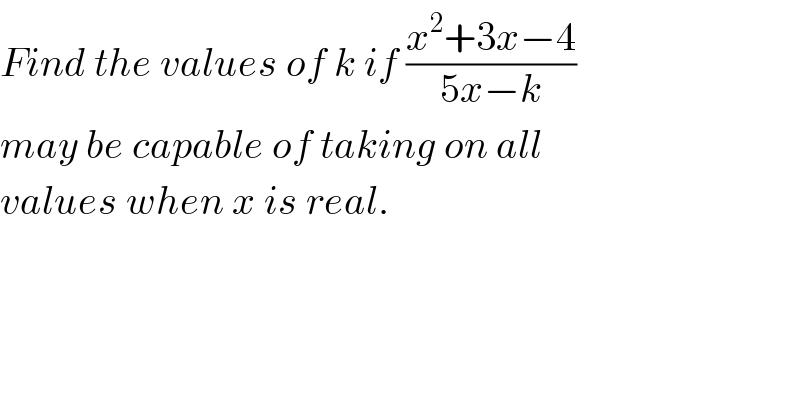
Question Number 33838 by NECx last updated on 25/Apr/18

$${Find}\:{the}\:{values}\:{of}\:{k}\:{if}\:\frac{{x}^{\mathrm{2}} +\mathrm{3}{x}−\mathrm{4}}{\mathrm{5}{x}−{k}}\: \\ $$$${may}\:{be}\:{capable}\:{of}\:{taking}\:{on}\:{all} \\ $$$${values}\:{when}\:{x}\:{is}\:{real}. \\ $$
Answered by MJS last updated on 26/Apr/18

$$\mathrm{we}\:\mathrm{have}\:\mathrm{to}\:\mathrm{get}\:\mathrm{rid}\:\mathrm{of}\:\mathrm{the}\:\mathrm{square}... \\ $$$$\frac{\mathrm{1}}{\mathrm{5}}×\frac{\left({x}+\mathrm{4}\right)\left({x}−\mathrm{1}\right)}{{x}−\frac{{k}}{\mathrm{5}}} \\ $$$$−\frac{{k}}{\mathrm{5}}=\mathrm{4}\:\vee\:−\frac{{k}}{\mathrm{5}}=−\mathrm{1} \\ $$$${k}=−\mathrm{20}\:\vee\:{k}=\mathrm{5} \\ $$$$\frac{{x}^{\mathrm{2}} +\mathrm{3}{x}−\mathrm{4}}{\mathrm{5}{x}−{k}}=\frac{\mathrm{1}}{\mathrm{5}}\left({x}−\mathrm{1}\right)\:\vee\:\frac{{x}^{\mathrm{2}} +\mathrm{3}{x}−\mathrm{4}}{\mathrm{5}{x}−{k}}=\frac{\mathrm{1}}{\mathrm{5}}\left({x}+\mathrm{4}\right) \\ $$
